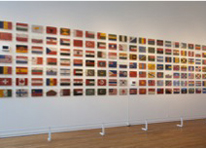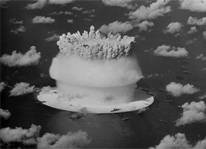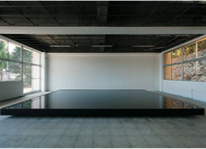Saturday 13th September - Sunday 26th October
Venues:
Onomichi:
Nishigosho Prefectural Warehouse No. 3 (8 minutes' walk from Onomichi Station)
10:00-17:00 (open every day throughout exhibition period)
Momoshima:
"Momoshima Toei" old movie theatre(13 minutes' walk from Fukuda Port),
10:00-17:00 (closed Tuesdays and Wednesdays,except Tuesday September 23rd)
ART BASE MOMOSHIMA is pleased to announce the exhibition "CROSSROAD", taking place at the two venues of Momoshima Island and the mainland city of Onomichi. The exhibition will run from Saturday 13th September to Sunday 26th October 2014. Next year will mark 70 years since the dropping of the atomic bomb on Hiroshima. There is debate regarding amendments to the Japanese constitution about the state's use of military force. It has also been 3 years since the Fukushima Daichi nuclear power plant disaster. It seems we still have not learned our lessons from continually contaminating the land of this country; rather, we continue today with an energy policy that relies on nuclear power. We constantly face crossroads in history. This exhibition will link the history and culture of Onomichi City - which was lucky to remain intact from war time air raids as well as the changes of the Bubble years - with the outlying island of Momoshima, in which the original beauty of Japanese landscapes remains preserved. The exhibition signals how we now faced with a crossroads of modernity, at which we must question what our ideals truly are. In Onomichi, along the waterfront in the vast space of warehouse No.3, YANAGI Yukinori and HARAGUCHI Noriyuki will show major large-scale new works. From the boat terminal across the sea to Momoshima, where in a long-abandoned building an old cinema will be brought to life once again, a large artwork by Yanagi will be relocated from the island of Inujima. In the art gallery of ART BASE MOMOSHIMA there will also be an exhibition of ISHIUCHI Miyako's "Hiroshima" series, as well as documentation and materials relating to Yanagi's "Inujima Project", which has brought back to life, through the power of art, the ruins of a Meiji-era copper refinery in a remote island of the Seto Inland Sea. Furthermore, a Bruce Conner film work will also be screened: "Operation Crossroads", a documentary film about the site at Bikini Atoll where the US carried out hydrogen bomb tests.In this exhibition revolving around the sites of Onomichi and Momoshima, we re-examine the lessons of history, and hope to create a chance to re-think our responsibilities towards the future.

《HIROSHIMA #9》,2007, Donor: Ogawa, R. © Ishiuchi Miyako N Collection
Born in Kiryu-shi, Gunma Prefecture. With her early photo trilogy, Ishiuchi captured the smell, mood, and atmosphere of a city, and following a later series of photographs titled 1・9・4・7, in which she depicted the hands and feet of women who were also born in the year of her birth, explored in a series of photographs scars on the human body. She received the 4th Kimura Ihei Award in 1979. In 2005, she represented Japan at the Venice Biennale with mother's 2000-2005: traces of the future. In 2008, she released the series ひろしま/hiroshima, which was shown at her solo exhibition at Hiroshima City Museum of Contemporary Art, as well as published as a book. In 2009, she received the 50th Mainichi Art Award. In 2012, the series, Silken Dreams, was featured in her solo exhibition held at the Marugame Genichiro-Inokuma Museum of Contemporary Art. In 2013, she took part in an exhibition titled Transformed Visions at Tate Modern by the Mexican publisher RM. In 2014, she received the Hasselblad Award Fromひろしま/hiroshima was published by Kyuryudo.
Noriyuki Haraguchi was born in Yokosuka, Kanagawa in 1946. He graduated from Nihon University College of Art, Department of Fine Arts. Haraguchi began his career as an artist in the late 1960s, and in 1977 made an impact in the Western art world by exhibiting a giant steel pool filled with oil waste at “Documenta 6,” a quadrennial international art festival in Kassel where he was the first Japanese to be selected. This was followed by his participation in the 10th Biennale de Paris; his first solo exhibition overseas was in 1978 at the Galerie Alfred Schmela in Dusseldorf. He gained an international reputation through large scale exhibitions such as “NORIYUKI HARAGUCHI,” his solo exhibition at the Städtische Galerie im Lenbachhaus in 2001, and “Das Schwarze Quadrat, Hommage en Malewitsch,” a hommage to Malevich in 2007. His recent activities include a first ever large-scale retrospective, “Noriyuki Haraguchi: Society and Matter,” which included the presentation of his new work at the BankART1929’s Studio NYK in Yokohama in 2009, evidence of his major influence and presence in the domestic art domain. In 2012, he was included in MOMA’s “Tokyo 1995-1970: A New Avant-garde” exhibition. “Oil Pool” he created for ART BASE MOMOSHIMA, is the one of the only two exist in the world as a sight-specific work.

《The World Flag Ant Farm》, 1990
Benesse Art Site Naoshima
Yukinori Yanagi was born in Fukuoka in 1959. He studied and obtained an M.F.A. at Yale University. He was the first Japanese artist to be awarded the a? prize at Aperto, in the 45th Venice Bienniale, in 1993. He resided and worked in New York from 1990, when his works were shown in solo exhibitions at Anthony d’Offay (London), Peter Blum (New York) , as well as at numerous international exhibitions such as the “Sao Paulo Biennale” (Brazil, 1996), and “Biennale de Lyon” (France, 1997). At the “Whitney Biennial 2000”, Yanagi was one of the first non-American artists selected for the exhibition. In 1992, his solo exhibition was held at Benesse House Museum (formerly The Naoshima Contemporary Art Museum). It was here that he was captivated by the beauty of the islands in the Seto Inland Sea, and later, in 1995, he encountered the abandoned copper refinery in Inujima, an island close to Okayama, for which he soon proposed an art project to reclaim the refinery titled “Inujima Project”. “Inujima Project” was finally achieved as The Inujima Seirensho Art Museum and opened to public in 2008. This industrial heritage site represents Japanese modernization in the Meiji Period and the messages of Yukio Mishima in the Showa Period, integrating them within the museum with the latest environmentally-conscious technology. Yanagi’s artworks are in a number of museum collections, such as MOMA, New York and London’s Tate Modern. His humorous and simultaneously provocative works have always been controversial, and his activities go well beyond the field of “art”. Since 2007, he has been the director of “Hiroshima Art Project”, a project that has seen the rebirth of unused spaces and facilities in Hiroshima city.

《CROSSROADS》, 1976
"Operation Crossroads" was the name of the first two of twenty-three nuclear weapons tests the United States conducted at Bikini Atoll between 1946 and 1958. Both tests involved the detonation of a weapon with a yield equivalent to twenty-three million tons of TNT–the same as the atom bomb dropped on Nagasaki. More than seven hundred cameras, and approximately five hundred camera operators surrounded the test site.Nearly half the world’s supply of film was at Bikini for the tests, making these explosions the most thoroughly photographed moment in history. "Conner found a cataclysmic beauty in the declassified National Archives footage of the first underwater atomic bomb test “Baker Day”, which was conducted on Bikini Atoll on July 25, 1946. Twenty-three shots of the same explosion—at differing speeds and distances, from air, sea, and land—combine with a mesmerizing dual score by Patrick Gleeson and Terry Riley to make of the destruction a kind of Cubist cosmic sublime." – Josh Siegel, Associate Curator, Department of Film, The Museum of Modern Art.
![企画展 十字路-CROSSROAD- [開催概要]](images/crossroad_titile.png)


